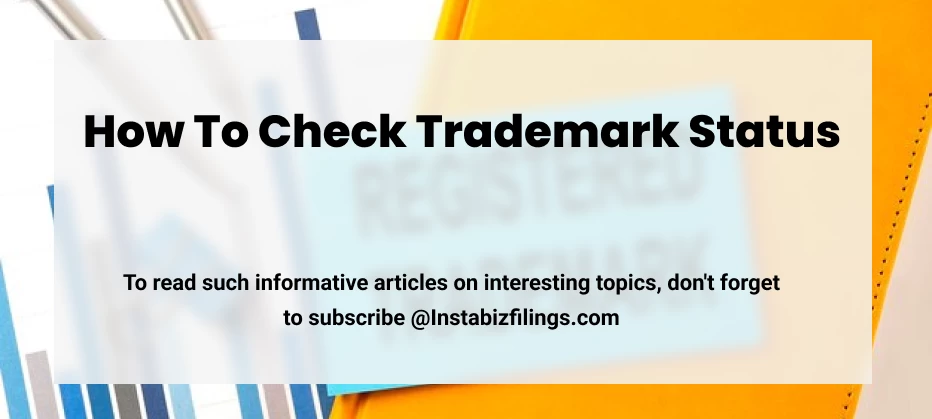
How To Check Trademark Status
October 29, 2024 by Team Instabizfilings
This phrase is the most purposive part of such a sentence as it denotes the principal feature of a trademark. A trademark can be a single word, short phrase, logo or an image, mark, hologram, brand-name, name, initials, signature, color, shape, sound, smell, taste or a combination of any two or more on the above mentioned. A trademark assists companies to distinguish their products from these of rivals by creating a brand which clients identify with. Just like a trademark gives meaning and sets the business apart while changing its status from a public firm to a private organization, the conversion is a strategic management move that redesigns the company’s identity and its freedom to operate.
Application for Registering a Trademark
1. Trademark Search:
-
It is recommended that one searches to ascertain that this chosen mark is well different from the rest and open for registration.
-
This can be done either through the Internet using the Intellectual Property tax India (IP India) website or through a trademark attorney.
2. Choose Trademark Classes:
-
Classify your goods and services into the right class or classes according to the Nice Classification system.
3. Prepare Application:
-
Gather necessary documents, including:
- First and last name, of the applicant, email address etc.
- Trademark reproduction (Logo, wordmark Etc)
- Declaration form
- Power of attorney, in case you will appoint the trademark counteragent
- Payment details
4. Online Filing:
-
Firstly, visit the official website of the IP India and register with your profile.
-
The belief that completing the online application with proper information is actually important is surely not wrong. Informed applicants for a program or any course make the right application and thus reduces cases of being disqualified or delayed.
-
Include the following documents.
-
Pay the government fees.
5. Examination:
-
The Trademark Registry will scrutinize your application in accordance with the laws of trademark.
-
In case of any complaints coming up, you can be required to manage them or alter your document.
6. Publication:
-
However, if the application is accepted, the trademark will be published in the Trademark Journal and anyone who wants to oppose the registration of the trademark will have to do so within thirty formations from the date of publication of the Application.
7. Registration Certificate:
-
That being the case, upon registering your trademark, there is a trademark registration certificate that you are issued.
Important Considerations
-
Professional Assistance: Thirdly there is need to consult the service of a trademark attorney especially where the above stages areDataContract 15 challenging.
-
Timeframe: Trademark registration is not a very swift process, it can take anything from several months on average.
-
Maintenance: It will also be relevant to point out that a trademark can be used indefinitely but must be renewed at some point in time.
Checking of Trademark Status in India is the Process as Follows
If you want to know the status of trademark application or registration in India then follow the below mentioned steps:
- Go to their website namely the Intellectual property India (IP India): Go to https://ipindia.gov.in/
- Locate the "Public Search" option: This is often found on the bottom of the page or, in any case, on the website’s main page following ‘Trademarks’.
- Enter your application or registration number: Some information will be necessary from you and this include the application number or registration number of your trademark.
- Submit the query: To do this you have to locate and click any search button or similar icon.
The website will display the current status of your trademark application or registration, including:
-
Application number
-
Filing date
-
Current status
-
Any objections or notices
-
Publication information as a part of the study if used
There are many kinds of statuses that apply to a trademark registration.
A trademark application may develop few statuses the application process indicating several conditions referring to the process of registration.A similar manner the Directors Report Format Companies Act, 2013 defining compliance pattern and discloser that are mandatory for any company for having proper discloser regarding functioning and financial position of the company.machine points out key discloser & compliance line which every company has to follow for being discloser or to have proper disclosures which are required at the time of discloser
Initial Stages
-
New Application: The application for trademark has been made.
-
Send to Vienna Codification: In case of the non-textual trademark, then the application is forwarded for classification.
-
Formalities Check Pass/Fail: It has at least met or not met the test upon the creation of the application.
Examination Stages
-
Marked for Exam: They are focusing on the application of the application under analysis.
-
Objected: Here objections have been raised by the examiner.
-
Exam Report Issued: The examiner has tendered objections in a report.
-
Refused: It has come as a decision to reject the application.
Post-Examination Stages
-
Accepted: To my delight the application I submitted has been received and approved.
-
Advertised: It is considered that the accepted trademark is published for opposition.
-
Opposed: An opposition has been filed.
-
Ready for Show Cause Hearing: It is taken because of resistance or for any other cause, and a hearing is set down.
Final Stages
-
Registered: This means the trademark itself has been registered and the proprietor only has the rights to the said trademark.
-
Abandoned: This happens when the applicant has not done what they were supposed to or is asked not to do in a certain period of time.
-
Withdrawn: Applicant allows for the cancellation of the application in a voluntary manner, this may as a result of changed business strategies or among other reasons.
-
Removed: The trademark is removed or expunged from the register for legal reasons or for failure of use for a stipulated period and other reasons.
Disclaimer
The information provided in this blog is purely for general informational purposes only. While every effort has been made to ensure the accuracy, reliability and completeness of the content presented, we make no representations or warranties of any kind, express or implied, for the same.
We expressly disclaim any and all liability for any loss, damage or injury arising from or in connection with the use of or reliance on this information. This includes, but is not limited to, any direct, indirect, incidental, consequential or punitive damage.
Further, we reserve the right to make changes to the content at any time without prior notice. For specific advice tailored to your situation, we request you to get in touch with us.


